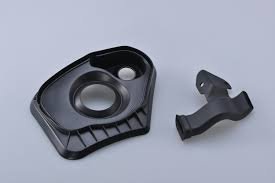Understanding Injection Molding Weld Lines: A Comprehensive Guide
Injection molding is a widely used manufacturing process that produces a vast range of plastic components. However, even with its efficiency and versatility, the process can introduce certain defects, one of which is known as a weld line. Weld lines are areas where two or more flow fronts meet during the injection molding process, and they often present challenges to the structural integrity and appearance of the final product. This article aims to provide an in-depth understanding of injection molding weld lines, exploring their causes, effects, and how to mitigate them.
What Are Injection Molding Weld Lines?
Injection molding weld lines, also known as knit lines or meld lines, occur when two or more flow fronts of molten plastic converge and cool in the mold. These lines often appear as visible or invisible marks on the surface of the molded part and can significantly affect the mechanical properties of the component. While they may not always be aesthetically pleasing, weld lines can also compromise the strength and durability of the final product, making it critical to address them during the design and manufacturing stages.
Causes of Weld Lines in Injection Molding
Weld lines form due to several factors, primarily related to the flow behavior of the molten plastic within the mold. Understanding these causes is essential for implementing strategies to reduce or eliminate weld lines. The main causes include:
- Flow Front Convergence: When molten plastic flows around obstacles, such as cores, inserts, or holes in the mold, the flow fronts split and later converge. The point where these fronts meet forms a weld line. Marine Salvage 101
- Material Viscosity: The viscosity of the plastic material affects how it flows within the mold. Higher viscosity materials may not flow as smoothly, leading to more pronounced weld lines.
- Mold Temperature: If the mold temperature is too low, the plastic may cool too quickly as it flows, resulting in weak weld lines. Conversely, a higher mold temperature can reduce the severity of weld lines by allowing the plastic to flow more freely.
- Injection Speed: The speed at which the plastic is injected into the mold can also influence weld line formation. Slower injection speeds may cause the plastic to cool prematurely, while faster speeds can help maintain a consistent flow.
- Part Design: The design of the part, including the placement of gates, vents, and ribs, can impact the formation of weld lines. Complex geometries are more likely to create multiple flow fronts, increasing the chances of weld lines.
Effects of Weld Lines on Product Quality
Weld lines can have several effects on the quality and performance of the final molded product:
- Reduced Strength: The area where weld lines form is often weaker than the surrounding material, leading to potential failure under stress or load. This is particularly critical in components that require high mechanical strength.
- Aesthetic Issues: Weld lines can be visible on the surface of the product, leading to cosmetic defects. This is especially problematic in consumer-facing products where appearance is crucial.
- Dimensional Variability: In some cases, weld lines can lead to dimensional inaccuracies, affecting the fit and function of the part in its intended application.
Strategies to Minimize Weld Lines
Minimizing weld lines is a key objective in injection molding, as it enhances both the mechanical properties and visual appeal of the final product. Several strategies can be employed to reduce or eliminate weld lines:
- Optimize Mold Design: Designing the mold to minimize the splitting of flow fronts can significantly reduce weld lines. This includes optimizing the placement of gates and runners, as well as considering the part’s geometry.
- Adjust Process Parameters: Fine-tuning the injection molding process, such as increasing mold temperature, adjusting injection speed, and controlling packing pressure, can help reduce weld lines.
- Use of Flow Aids: Certain additives and fillers can be used to improve the flow of the molten plastic, reducing the likelihood of weld line formation.
- Material Selection: Choosing a material with lower viscosity or better flow characteristics can help minimize weld lines. Additionally, materials with higher weld line strength can be selected for critical applications.
- Cooling Optimization: Ensuring uniform cooling throughout the mold can help maintain consistent flow and reduce weld lines. This may involve modifying the cooling channels or adjusting the coolant flow rate.
Frequently Asked Questions (FAQs) About Injection Molding Weld Lines
Q: Are weld lines always visible on the final product?
A: Not necessarily. Weld lines can sometimes be invisible to the naked eye, especially if they are shallow or if the part’s color and texture mask them. However, even invisible weld lines can affect the strength and durability of the product.
Q: Can weld lines be completely eliminated?
A: While it may not be possible to completely eliminate weld lines in all cases, they can be significantly minimized through careful design and process optimization. In some applications, reducing their impact on strength and appearance is the primary goal.
Q: How do weld lines affect the strength of the molded part?
A: Weld lines create areas of weakness where the material may not bond as well as in other areas, leading to reduced tensile strength and potential failure under stress.
Q: What role does material choice play in weld line formation?
A: Material choice is crucial. Materials with better flow properties and higher weld line strength are less likely to exhibit pronounced weld lines. Additionally, certain materials are more prone to weld line formation due to their viscosity or cooling behavior.
Q: How can I detect weld lines in my molded parts?
A: Weld lines can often be detected through visual inspection, especially if they appear as visible marks on the surface. In cases where weld lines are not visible, non-destructive testing methods such as ultrasonic or X-ray inspection can be used.
Conclusion
Injection molding weld lines, while common, do not have to compromise the quality and performance of your products. By understanding their causes and implementing effective strategies, you can minimize their impact and produce high-quality, durable parts that meet your specifications. Whether you are designing a new part or optimizing an existing process, addressing weld lines early on can lead to better outcomes and greater satisfaction for your customers.






